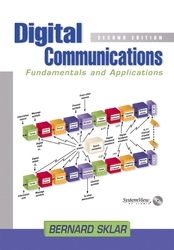Pseudo Random Signal Processing: Theory and Application (Hardcover)
暫譯: 偽隨機信號處理:理論與應用(精裝版)
Hans-Jurgen Zepernick, Adolf Finger
- 出版商: Wiley
- 出版日期: 2005-11-01
- 售價: $1,560
- 貴賓價: 9.8 折 $1,529
- 語言: 英文
- 頁數: 436
- 裝訂: Hardcover
- ISBN: 0470866578
- ISBN-13: 9780470866573
下單後立即進貨 (約5~7天)
買這商品的人也買了...
-
 系統分析與設計概論 (Essential of Systems Analysis and Design)
系統分析與設計概論 (Essential of Systems Analysis and Design)$480$379 -
 數位影像處理 (Digital Image Processing, 2/e)
數位影像處理 (Digital Image Processing, 2/e)$820$804 -
 IBM PC 組合語言與程式設計 (IBM PC Assembly Language and Programming, 5/e)
IBM PC 組合語言與程式設計 (IBM PC Assembly Language and Programming, 5/e)$580$458 -
 Linux 指令詳解辭典
Linux 指令詳解辭典$650$514 -
 最新詳解 Javascript & HTML & CSS 語法辭典(增訂新版)
最新詳解 Javascript & HTML & CSS 語法辭典(增訂新版)$490$382 -
 深入淺出設計模式 (Head First Design Patterns)
深入淺出設計模式 (Head First Design Patterns)$880$695 -
 Word 2003 實力養成暨評量解題秘笈
Word 2003 實力養成暨評量解題秘笈$150$119 -
 資料庫系統原理 (Fundamentals of Database Systems, 4/e)
資料庫系統原理 (Fundamentals of Database Systems, 4/e)$860$679 -
 深入淺出 Java 程式設計, 2/e (Head First Java, 2/e)
深入淺出 Java 程式設計, 2/e (Head First Java, 2/e)$880$695 -
 Linux Mail Server 技術實務─架設、稽核、防毒、防垃圾信
Linux Mail Server 技術實務─架設、稽核、防毒、防垃圾信$580$458 -
 CSS 功能索引式參考手冊
CSS 功能索引式參考手冊$390$308 -
 鳥哥的 Linux 私房菜基礎學習篇, 2/e
鳥哥的 Linux 私房菜基礎學習篇, 2/e$780$663 -
 ASP.NET 2.0 深度剖析範例集
ASP.NET 2.0 深度剖析範例集$650$507 -
 SQL Server 2005 Reporting Services 報表服務實務應用
SQL Server 2005 Reporting Services 報表服務實務應用$620$484 -
 Visual C# 2005 建構資訊系統實戰經典教本
Visual C# 2005 建構資訊系統實戰經典教本$650$507 -
 Dreamweaver 搞不定的網頁設計效果:CSS 關鍵救援密碼
Dreamweaver 搞不定的網頁設計效果:CSS 關鍵救援密碼$520$411 -
 Ajax 實戰手冊 (Ajax in Action)
Ajax 實戰手冊 (Ajax in Action)$680$537 -
 時間管理─給系統管理者 (Time Management for System Administrators)
時間管理─給系統管理者 (Time Management for System Administrators)$480$379 -
 Ajax 快速上手 (Head Rush Ajax)
Ajax 快速上手 (Head Rush Ajax)$780$616 -
 聖殿祭司的 ASP.NET 2.0 專家技術手冊─使用 C#
聖殿祭司的 ASP.NET 2.0 專家技術手冊─使用 C#$720$569 -
 Linux 核心詳解, 3/e (Understanding the Linux Kernel, 3/e)
Linux 核心詳解, 3/e (Understanding the Linux Kernel, 3/e)$1,200$948 -
 SQL 之美學 (The Art of SQL)
SQL 之美學 (The Art of SQL)$620$490 -
 Memory Dump Analysis Anthology, Volume 2 (Paperback)
Memory Dump Analysis Anthology, Volume 2 (Paperback)$1,620$1,539 -
 Google Android SDK 開發範例大全
Google Android SDK 開發範例大全$750$638 -
 Linux 驅動程式開發實戰 (Essential Linux Device Drivers)
Linux 驅動程式開發實戰 (Essential Linux Device Drivers)$750$638
商品描述
Description:
In recent years, pseudo random signal processing has proven to be a critical enabler of modern communication, information, security and measurement systems. The signal’s pseudo random, noise-like properties make it vitally important as a tool for protecting against interference, alleviating multipath propagation and allowing the potential of sharing bandwidth with other users.
Taking a practical approach to the topic, this text provides a comprehensive and systematic guide to understanding and using pseudo random signals. Covering theoretical principles, design methodologies and applications, Pseudo Random Signal Processing: Theory and Application:
- sets out the mathematical foundations needed to implement powerful pseudo random signal processing techniques;
- presents information about binary and nonbinary pseudo random sequence generation and design objectives;
- examines the creation of system architectures, including those with microprocessors, digital signal processors, memory circuits and software suits;
- gives a detailed discussion of sophisticated applications such as spread spectrum communications, ranging and satellite navigation systems, scrambling, system verification, and sensor and optical fibre systems.
Pseudo Random Signal Processing: Theory and Applicationis an essential introduction to the subject for practising Electronics Engineers and researchers in the fields of mobile communications, satellite navigation, signal analysis, circuit testing, cryptology, watermarking, and measurement. It is also a useful reference for graduate students taking courses in Electronics, Communications and Computer Engineering.
Table of Contents:
Preface.List of abbreviations.
List of common symbols.
1. Introduction.
1.1 Prologue.
1.2 Elements of pseudo random signal processing.
1.3 Outline of the book.
2. Characterization of signals and sequences.
2.1 Classification of signals and sequences.
2.2 Transformations of signals and sequences.
2.3 Correlation measures.
2.4 Power spectral density.
2.5 Pseudo random signals and sequences.
3. Mathematical foundations.
3.1 Algebraic structures.
3.2 Polynomials over finite fields.
4. Binary pseudo random sequences.
4.1 Classification.
4.2 Maximal-length sequences.
4.3 Binary sequences with good autocorrelation.
4.4 Binary sequences with special cross-correlation.
5. Nonbinary pseudo random sequences.
5.1 Classification.
5.2 Interference-free window sequences.
5.3 Complex-valued sequences.
5.4 Polyphase sequences with special correlations.
6. Generating pseudo random signals.
6.1 Linear autonomous automata.
6.2 Generating maximal-length sequences.
6.3 Transformations of maximal-length sequences.
6.4 Combinations of maximal-length sequences.
6.5 Pseudo random signal processing with microprocessors and memory circuits.
7. Applications of pseudo random signal processing.
7.1 Spread spectrum communications.
7.2 Ranging and navigation systems.
7.3 Scrambling.
7.4 Automatic testing and system verification.
7.5 Cryptology.
7.6 Other applications.
Bibliography.
Index.
商品描述(中文翻譯)
描述:
近年來,偽隨機信號處理已被證明是現代通信、信息、安全和測量系統的重要推動力。信號的偽隨機、噪聲般的特性使其成為防止干擾、緩解多徑傳播以及與其他用戶共享頻寬的關鍵工具。
本書採取實用的方式來探討這一主題,提供了一個全面且系統的指南,以理解和使用偽隨機信號。涵蓋理論原則、設計方法論和應用,《偽隨機信號處理:理論與應用》:
- 設定實施強大偽隨機信號處理技術所需的數學基礎;
- 提供有關二進制和非二進制偽隨機序列生成及設計目標的信息;
- 檢視系統架構的創建,包括微處理器、數字信號處理器、記憶電路和軟體套件;
- 詳細討論複雜應用,如擴頻通信、測距和衛星導航系統、加密、系統驗證以及傳感器和光纖系統。
《偽隨機信號處理:理論與應用》是對於從事電子工程的專業人士和在移動通信、衛星導航、信號分析、電路測試、密碼學、水印技術和測量領域的研究人員的重要入門書籍。對於修習電子學、通信和計算機工程課程的研究生來說,它也是一本有用的參考書。
目錄:
前言。
縮寫列表。
常用符號列表。
1. 介紹。
1.1 序言。
1.2 偽隨機信號處理的元素。
1.3 本書大綱。
2. 信號和序列的特徵化。
2.1 信號和序列的分類。
2.2 信號和序列的變換。
2.3 相關性度量。
2.4 功率譜密度。
2.5 偽隨機信號和序列。
3. 數學基礎。
3.1 代數結構。
3.2 有限域上的多項式。
4. 二進制偽隨機序列。
4.1 分類。
4.2 最大長度序列。
4.3 具有良好自相關的二進制序列。
4.4 具有特殊交叉相關的二進制序列。
5. 非二進制偽隨機序列。
5.1 分類。
5.2 無干擾窗口序列。
5.3 複數值序列。
5.4 具有特殊相關性的多相序列。
6. 生成偽隨機信號。
6.1 線性自主自動機。
6.2 生成最大長度序列。
6.3 最大長度序列的變換。
6.4 最大長度序列的組合。
6.5 使用微處理器和記憶電路的偽隨機信號處理。
7. 偽隨機信號處理的應用。
7.1 擴頻通信。
7.2 測距和導航系統。
7.3 加密。
7.4 自動測試和系統驗證。
7.5 密碼學。
7.6 其他應用。
參考文獻。
索引。



























